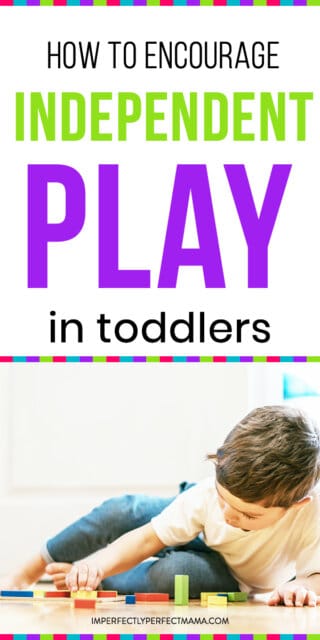Little people are busy trying to understand how things work in the world around them.

They are doing this research every single day restlessly from morning till night.
The main activity which enables children to learn and accept the world around them is play.
While it may seem that it is just fun and no value-creating activity that they are busy with, but it is their job.
What is Independent Play?
Play is a crucial activity in a child’s world – it is the way to calm down, to play all the stress out, to repeat situations noted earlier and absorb, understand them better.
It is a way to master the motors, the speech, the decision making and boost the imagination. The power of play is to create a whole human being.
Iben Sandahl, the author of Play the Danish Way, notes that free unstructured play enables children to deal with anxiety and become more resilient. Through play, little humans may get the feeling of control over situations and become more self-esteemed.
Children may try various new things in the reality of the play.
They enrich themselves by gaining experience of succeeding or failing and trying again in this way building persistence and confidence which later is used in real-life situations.
Children shape their mindset by “living” various scenarios in imaginary situations.
And when they find themselves in similar circumstances outside the safe world of play they are more confident in themselves.
Iben Sandahl also points out that play helps children to relieve stress and acknowledge all the emotions and impressions gathered during the day. It is time for them to adjust to new experiences and reconnect with themselves.
Jessica Joelle Alexander, a co-author of The Danish Way of Parenting, that the world of free play is enriching for children. It enables their imagination and creativity to thrive and provides a way to explore their fears and limitations.
Avital Schreiber Levy, a Childhood Designer and Mindful Parenting Coach, facilitates the idea of deep play when the child is lost in the flow and forgets about everything else around him.
And parents should protect those moments by not interrupting with comments, praises, valuations, or suggestions.
They should respectfully let the child immerse himself into the play and get lost in the moment.
What If Your Child Does Not Play on His Own?
Little ones may refuse to play on their own because they are used to the adults being around and involving themselves in most of the activities happening around them.
According to the attached parenting principles, parents should wrap their babies with attention, care, and love as much as they can so the baby feels safe and happy in this big world.
Parents do their best in providing the babies with the best first experiences of their lives. And the new mothers and fathers adapt to this state – they play together and talk and try to name all the objects and activities happening around so that children hear as much of natural speech as possible and gather all those sounds in their brain and then try to pronounce them themselves.
This is a great method for helping children to start to speak early and to help them express their needs.
But then this close cooperation may become a little bit of a burden when your child gets too clingy and wants you to participate in all his activities, including play.
It may prevent the child from the pure and immersing joy of play when he loses himself in a flow and forgets about time since you try to participate by commenting and suggesting ideas and it distracts your little one from the deep dive into the magic of play.
He is also prevented from using his imagination, ideas, and creativity.
Therefore sometimes you may use some tactics to separate from your child and try to promote the idea of playing alone without any structure, guidance, or implied scenarios.
If your child refuses to play on his own and insists that you would be by his side try:
- To be as neutral as possible. Be there, but do not imply your ideas, do not make suggestions, answer child’s questions with one word or if he wants you to tell something more – ask his opinion how can the situation be solved
- To leave him for a few minutes saying that you have to do some task. For example, you are going to make a cup of tea and will come back soon. You should keep your promise and come back. Next time try to leave him for a longer period until he gets used to spending some time alone with you being around.
How to Spark Independent Play
- Have all screens and distracting radio voices shut down. Screens are always the preference over the good old play so try to make their choice easier.
- Sort the toys and eliminate all the broken, unattractive, too specific, flashy and loud ones. Leave the simple ones which can be used in various situations and build up creativity. As toys are the main tools for the job of play that little people are busy with, they should be of good quality, multipurpose, and in moderate numbers. Too many toys may seem overwhelming and the child may not know where to begin.
- Have a play friendly mindset. Do not forbid unusual usage of household equipment as long as it is save to play with, try to see the mess as the outcome of creativity, and invite the causer of it to tidy up together. Make your home a play friendly and safe place for experiments, imagination, and creativity to thrive.
- Be around to assure them that they are not alone. Little children can relax best when their caregivers are there for them but do not interrupt the play. Say nothing if you see that child is caught in the moment. Do not praise or comment. Let him dive into the pleasure of play.
- Help your child start. Bring selected toys to a specific place, ask where to put them, what imaginary situation are they in, what are they busy with. When he gets involved and tells you the story by himself and shows you what each toy is doing – join him for a while and then keep silent for some time, see if he notices that. Then move to a different part of the room or another room without any disturbing sounds so that you do not “wake up” your child from his imaginary world.
- Try to keep your phone on silent mode if possible. Or go to another room to have a conversation. Just show respect for the little person’s activity as you would show for your husband, colleague, or friend.
- Try to leave hints for possible play scenarios. Or Strew – unexpectedly and in different ways grouped toys will catch the attention of the little explorer and spark curiosity and imagination which will lead him into the magic world of play.
Dr. Laura Markham, an author of Peaceful Parents, Happy Kids: How to Stop Yelling and Start Connecting, says that parents are also teachers to their kids, but sometimes adults overdo it by taking over all the initiative in play and teach children that they are better at play and children can not do without them.
Dr. Markham also notes that by engaging kids to an enormous number of activities, keeping them busy with screens, parents weaken their natural ability to play.
Which is an essential way for them to cope with new experiences, emotions, learn about themselves, and be harmonious and happy.
Just Let Them Play
“Children come into the world with instinctive drives to educate themselves. These include the drives to play and explore.” – Peter Gray, Ph.D., Freedom to Learn
As people who manage every day of children, we should leave them time to play freely. It is one of the best ways to show them love and care.
This is also one of the best ways for children to develop and be what they are meant to be.




Leave a Reply